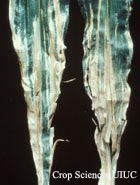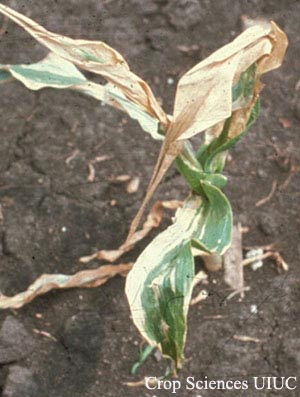Stewart's Wilt



Symptoms
- This disease has two phases and primarily is a problem on sweet corn and susceptible inbreds, although resistant hybrids may be affected if flea beetle populations are very high in the spring.
- The first phase affects corn seedlings. Seedling leaves have light green to yellow linear streaks with wavy margins that can follow the length of parallel veins. Plants can become necrotic and die. The plants may produce bleached tassels if it survives.
- The second phase is leaf blight after tasseling. Leaves develop light green or yellow streaks along veins. Infected areas will die. The disease can be severe enough to kill the entire leaf. With the absence of resistance, the leaf blight phase can be a threat to field corn.
Pathogen Involved
- Erwinia (=Pantoea) stewartii (a bacterium)
- Overwinters in and is transmitted by the corn flea beetle
- Many grass hosts are susceptible
- Can be seed transmitted at a low rate
Time of Occurrence
- Seedling stage and the leaf blight phase occur after tasseling
Conditions Favoring Disease
- Warm winters and high corn flea beetle populations in spring
- Susceptible inbreds and sweet corn
- High levels of soil phosphorus and nitrogen
- High temperatures and soil moisture
Disease Management
- Use resistant corn hybrids
- Seed-applied insecticides can be beneficial
- Disease forecasting is based on the sum of mean temperatures for December, January, and February. In mild winters, the corn flea beetle will have a high survival rate and disease severity may be high. In cold winters, corn flea beetles will have low survival and disease would likely be low severity or absent.